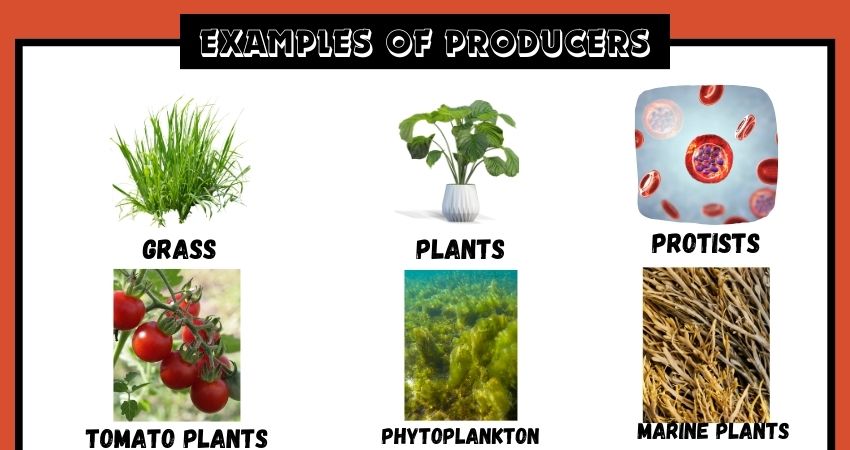A producer is someone who creates and supplies goods or services. Plants, trees, shrubs, cyanobacteria, and certain bacteria are a few examples of producers.
Real life Examples of Producers
- Grass: Found in terrestrial ecosystems, grass is a common producer that supports a variety of herbivores.
- Oak Tree: A towering example of a terrestrial producer, oak trees contribute to forest ecosystems and provide habitat for numerous organisms.
- Sunflowers: These vibrant flowers not only beautify landscapes but also serve as producers through photosynthesis.
- Phytoplankton: Microscopic algae floating in aquatic environments, phytoplankton forms the basis of marine and freshwater food chains.
- Bamboo: A fast-growing plant, bamboo is a producer in various ecosystems and is essential for many herbivores.
- Cactus: Well-adapted to arid environments, cacti are producers that store water in their fleshy stems.
- Seaweed: In marine environments, seaweed and algae contribute to the productivity of coastal ecosystems.
- Rice Plants: An important food crop, rice plants are terrestrial producers that support human and animal populations.
- Corn Plants: Widely cultivated, corn plants are essential producers in agriculture, providing food and resources.
- Ferns: These ancient plants are producers that thrive in various environments, including forests and tropical climates.
- Moss: Common in damp environments, mosses are small producers contributing to soil health.
- Pine Trees: Found in coniferous forests, pine trees are terrestrial producers providing habitat and resources.
- Tomato Plants: Cultivated worldwide, tomato plants are producers providing nutritious fruits.
- Algae Mats: In aquatic environments, algae mats contribute to nutrient cycling and provide a source of energy.
- Wheat Plants: A staple crop, wheat plants are terrestrial producers supporting human populations.
- Fruit Trees (e.g., Apple Trees): Fruit-bearing trees are producers that provide sustenance for various animals.
- Succulents: Plants like aloe vera are adapted to arid conditions and serve as producers in deserts.
- Soybean Plants: A significant crop, soybeans are terrestrial producers with various industrial uses.
- Eucalyptus Trees: Native to Australia, eucalyptus trees are terrestrial producers with aromatic leaves.
- Mushrooms: Although not plants, mushrooms are fungi that play a role as decomposers and are considered producers in a different sense, contributing to nutrient cycling.
Examples of Producers in Terrestrial Food Chains
Plants
At the forefront of terrestrial food chains are plants, the quintessential producers. Through photosynthesis, they convert sunlight into energy, laying the foundation for the entire ecosystem.
Trees
Toweringly majestic, trees stand as silent sentinels in terrestrial ecosystems, converting sunlight into sustenance. Their role extends beyond mere aesthetics, shaping the environment for countless species.
Small Shrubs
Even the modest small shrubs contribute significantly as producers. Their ability to thrive in various climates makes them essential players in terrestrial food chains.
Fruit-Bearing Plants
Fruits are not just delectable treats; they are also a crucial link in the food chain. Fruit-bearing plants produce the nutrition that sustains a myriad of herbivores.
Examples of Producers in Aquatic Food Chains
Phytoplankton
In the vast expanse of oceans, phytoplankton reign supreme as microscopic powerhouses. These tiny organisms, through photosynthesis, generate the majority of the world’s oxygen and form the base of marine food chains.
Algae
From freshwater ponds to the ocean depths, algae thrive as aquatic producers. Their diverse forms and adaptability make them foundational in sustaining aquatic ecosystems.
Marine Plants
Beyond the shallows, various marine plants contribute to the richness of aquatic food chains. Seagrasses and other submerged vegetation provide habitat and sustenance for an array of marine life.
Protists
Microscopic and often overlooked, protists play a vital role as producers in aquatic environments. Their diverse forms contribute to the intricate balance of marine ecosystems.
Unique Producers in Specialized Environments
Bacterium in Deep Ocean Areas
In the mysterious depths of the ocean, bacterium takes on the role of a unique producer. These extremophiles harness energy from the chemical richness of the deep sea, showcasing life’s adaptability.
Lichen in Arctic Tundras
In the vast expanses of Arctic tundras, where temperatures plummet and the landscape appears inhospitable, lichen emerges as a remarkable producer. A symbiotic association between fungi and algae, lichen can thrive in the harshest climates.
Halophytes in Saline Environments
Salt flats and saline environments present a challenge for many plants, but halophytes have evolved to conquer these harsh conditions. These specialized producers can tolerate high levels of salt, extracting nutrients from saline soils. Mangroves, for example, are halophytes that thrive in coastal areas, contributing to the stabilization of shorelines and providing habitats for diverse ecosystems.
Xerophytes in Arid Deserts
Arid deserts, with their scorching temperatures and limited water availability, are home to a unique group of producers known as xerophytes. These plants have evolved various adaptations to conserve water and thrive in desert conditions. Succulents, such as cacti, store water in their fleshy tissues, while others have developed extensive root systems to capture and utilize scarce water resources.
Cryptogamic Crusts in Drylands
In arid and semi-arid regions, where the soil surface is often dry and barren, cryptogamic crusts emerge as unexpected producers. These biological soil crusts consist of a community of lichens, mosses, algae, and bacteria.

